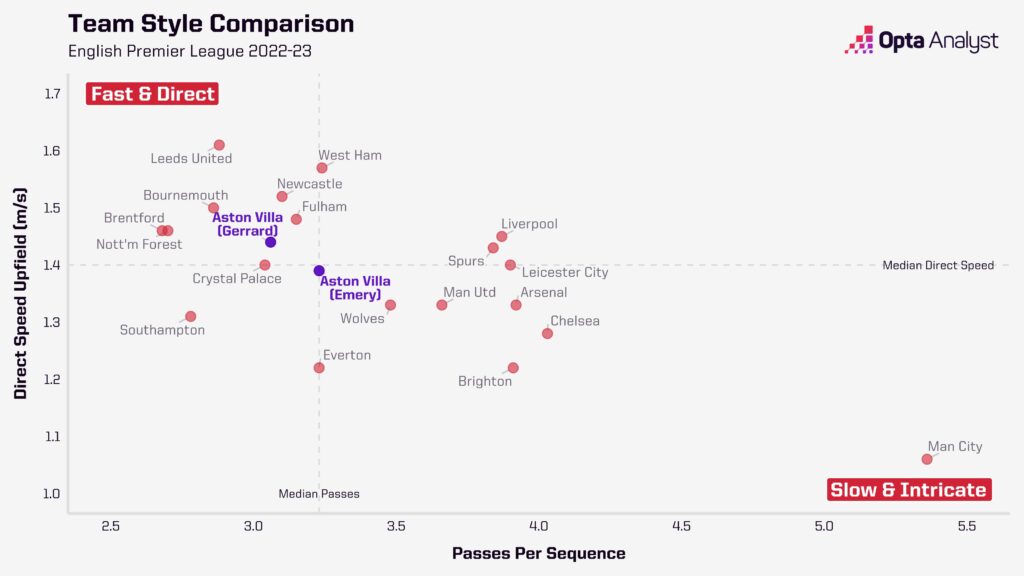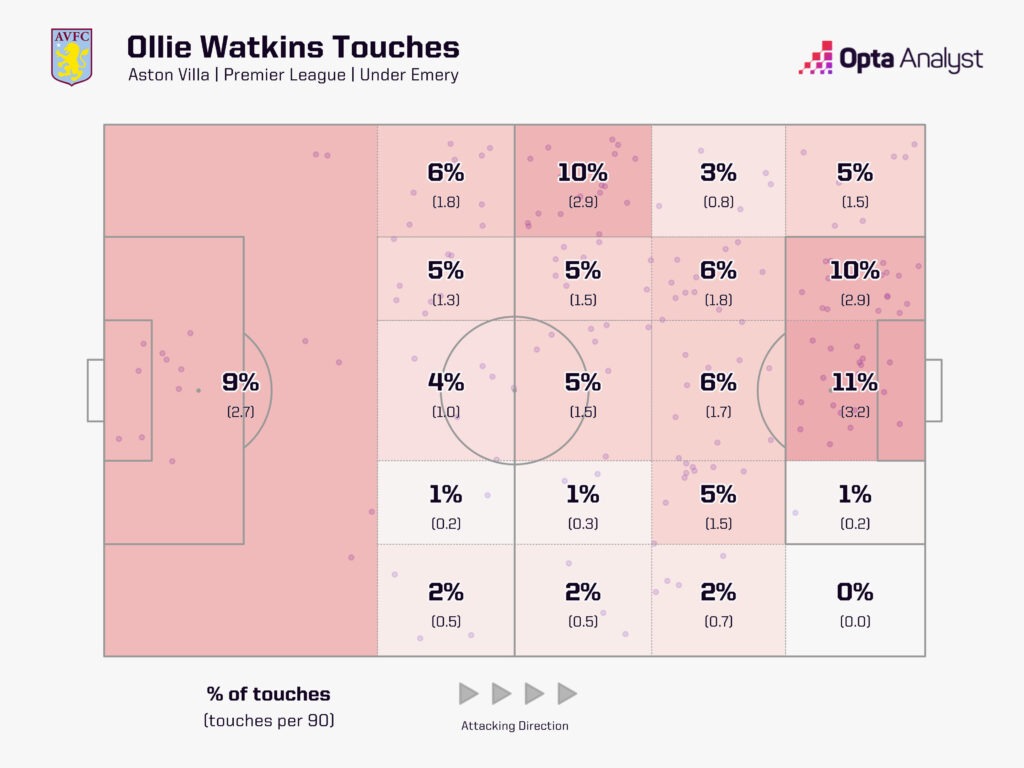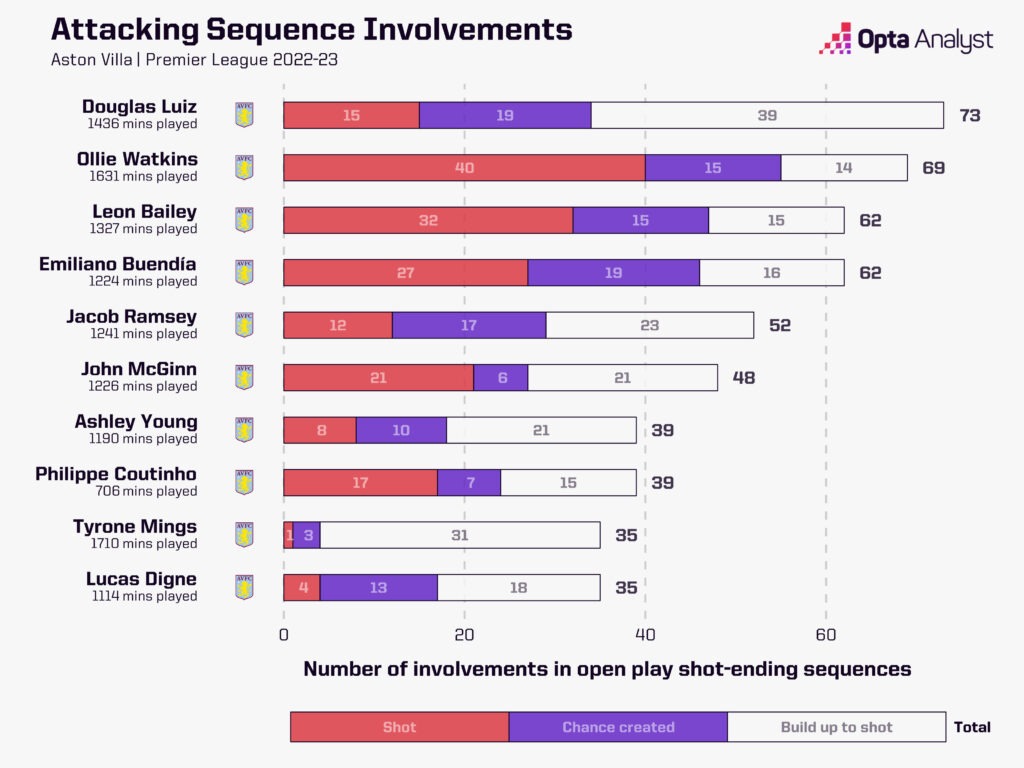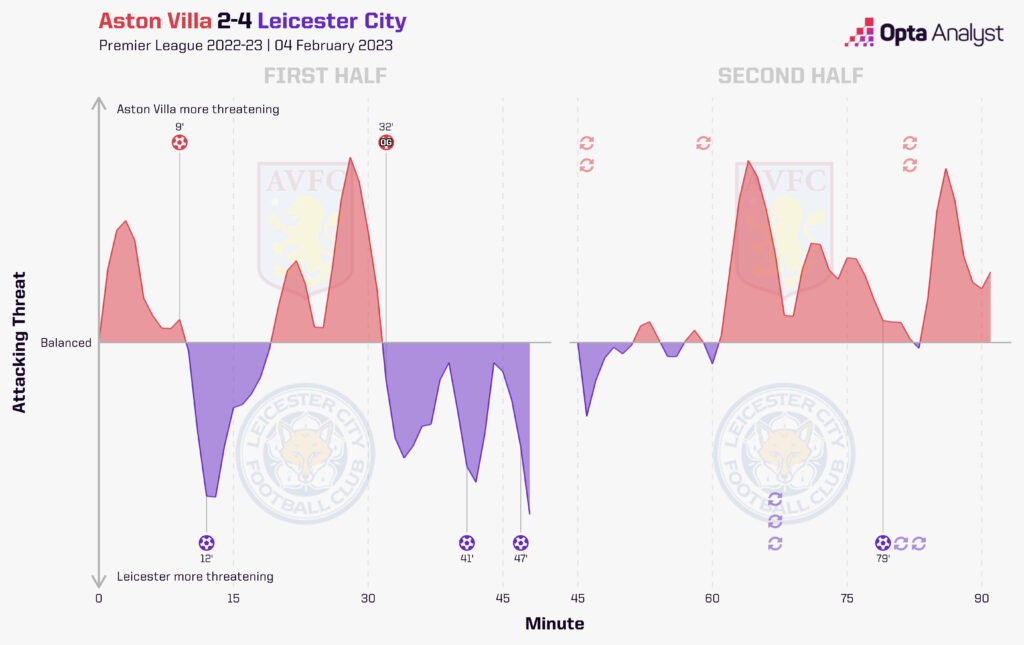The Villa Park hotseat had barely cooled to lukewarm temperature when Aston Villa appointed Unai Emery to succeed Steven Gerrard – just three days after sacking the latter amid an increasingly toxic atmosphere precipitated by a wretched start to the season. And on the evidence of Emery’s short tenure so far, it’s not hard to see why Villa moved so decisively to get their man.
Since Emery took over in the West Midlands, having left Villarreal, only Premier League leaders Arsenal (where in 2019 he suffered his only sacking in five previous jobs in Europe’s top five leagues), third-placed Manchester United, and Brentford have picked up more points than Villa (16, as many as second-placed Manchester City – from one fewer game).
Following Gerrard’s final match in charge, a miserable 3-0 defeat at Fulham on 21 October, Villa sat one place above the relegation zone with nine points from 12 games. Now, European qualification is not entirely out of the question.
As Emery and Villa look to bounce back from a surprise 4-2 home defeat to Leicester when they travel to Man City this weekend, we assess how the former Valencia, Sevilla and Paris Saint-Germain boss has got them firmly back on track after a miserable start to 2022-23.

When Villa fans chanted for Gerrard to ‘get out of our club’, their ire was palpable – and, while unpleasant to witness as such a venomous display of discontent always is, understandable. All things considered, Gerrard’s 11-month reign in the West Midlands was little short of disastrous: he finished with a win percentage of 32.5%, one of the lowest in the club’s 149-year history and almost 10% lower than that of the man he replaced, Dean Smith. With hindsight, the appointment of Gerrard – who had led Rangers to the Scottish Premiership title but was still hardly proven as a manager – looks like a considerably bigger punt than it did at the time.
In Emery, Villa have the closest thing to an elite manager since Martin O’Neill – who guided them to three successive sixth-placed Premier League finishes between 2008 and 2010. The 51-year-old Basque came in for all manner of stick at Arsenal, but this is someone who has reached five Europa League finals, winning four (three with Sevilla and one with Villarreal, also steering the latter to last season’s Champions League semi-finals), and clinched the French domestic treble with PSG in 2017-18. Emery has also never finished lower than ninth in 13 full top-flight campaigns (10 in Spain, two in France, one in England), with an average final placing of 4.7; regardless of the relative strengths of the different leagues, that’s not a record to be sniffed at.
Emery’s first batch of Villa fixtures looked pretty tough on paper: bang in-form Manchester United at home; impressive Brighton away; out-of-sorts yet, then, still not-to-be-taken-lightly Liverpool at home; top-four battlers Tottenham away; and a West Midlands derby at home to Wolves, who themselves had just appointed an ex-Sevilla boss in Julen Lopetegui. As it happened, Villa won three and drew one of those five matches, losing only to Liverpool. And Emery’s reign could hardly have got off to more of a flyer if he’d strapped jet packs to his players: Villa comfortably beat United 3-1, recording their first home win against them since 1995.
The most immediately discernible change implemented by Emery was always likely to be formational. While Gerrard tended to favour a 4-3-3 (although he also tweaked to a 4-3-1-2 on a fair few occasions), Emery has deployed a 4-2-2-2 (recently used in the Premier League by Ralph Hasenhüttl at Southampton and Ralf Rangnick at Manchester United), an adaptation of his highly effective 4-4-2 at Villarreal. It’s a set-up which lends itself to the kind of counter-attacking football with which Emery has enjoyed plenty of success as a manager.
Gerrard’s Villa were… chaotic with the ball, which fed into their wastefulness in front of goal. In his 38 Premier League matches as head coach, Villa posted a non-penalty expected goals total of 45.48 (1.19 npxG/game and 0.09 npxG/shot) – and slightly underperformed against that, scoring 44 non-penalty goals. They converted a fraction over 37% of their big chances (20/54 big chances scored, including one penalty), the fourth-lowest percentage in the division among ever-present teams across that period.
As much as anything, Emery has brought control to this Villa side. While their creative output remains more or less at Gerrard-era levels – they’ve averaged 1.24 npxG/game (0.10 npxG/shot) under Emery – Villa are slightly more intricate and patient in their build-up, attempting 452 passes per game compared to 414/game under Gerrard. Their average chance quality hasn’t changed by any remotely meaningful degree, but, perhaps because of this much more discernible structure in possession there seems to have been a marked increase in composure: that big-chance conversion rate has gone up to 61.5% (8/13 big chances scored, including one penalty).

Spearheading the Villa attack is a player who’s been particularly rejuvenated since Emery came in: Ollie Watkins – who’s been involved in seven of Villa’s 18 goals in all competitions under their new (ish) head coach, in nine appearances. That’s as many goal contributions as the 27-year-old had managed in his previous 18 outings (16 under Gerrard and two under caretaker Aaron Danks).
While Watkins was used in various capacities by Gerrard – through the middle or on the right of a front three, or as one half of a front two – he’s so far only been used in a strike duo by Emery, partnered by Bailey on five occasions and Emi Buendia once. Consequently, he’s been more involved at the sharp end of the pitch, averaging 6.3 touches in the box per 90 under Emery compared to 4.8 across Gerrard’s 11 matches this season. The seven-cap England international scored the only goal of the game in Villa’s last win – away to Southampton the matchday before last – and could well be putting himself in Gareth Southgate’s thoughts for next month’s internationals.

With the odd exception, Watkins has been partnered up front by Leon Bailey – whose Villa career had yet to really take off. It still hasn’t, but the Jamaica international has started to show signs that he, too, could really benefit from Emery’s structure. And that’s come after he was on the brink of being dropped following poor showing against Wolves – when he missed an open-goal chance worth 0.83 xG – and Stevenage, as Villa were stunned in the third round of the FA Cup by the fourth-tier side.
Throw January signing Jhon Duran – who registered 14 goal contributions (eight goals, six assists) in 28 games for MLS outfit Chicago Fire – and Emery has a solidvariety of striking options to work with. Neither Bailey nor Buendia are out-and-out centre-forwards, but they seem to slot more seamlessly into Emery’s methods than they ever did Gerrard’s chaos.
Meanwhile, Douglas Luiz has continued to thrive since Emery took over. Luiz was already looking right at home in the more advanced midfield role he’d been afforded by the summer arrival of Boubacar Kamara, now the anchor in Emery’s central midfield duo – having often been exposed defensively while operating deeper – and the change of head coach hasn’t changed that one bit.
With four assists this term, Luiz is Villa’s joint leading provider in the league alongside Watkins. He’s also created 26 chances at 1.6/90 (both team highs) and also leads the way for secondary chances created. His importance in Villa’s open-play shot production is also witnessed through his team-high 73 attacking sequence involvements, with his 39 involvements in the build-up to an open play shot (not the shot itself or the chance created) testament to his value in the centre of the midfield.

Four of Luiz’s six goal involvements have come under Emery, whose system naturally allows him to make the most of his attacking qualities – which he exhibited in last month’s 2-0 victory at Spurs, playing a neat one-two with John McGinn, whose return pass he controlled with a sublime first touch before slotting the ball past Hugo Lloris with the outside of his foot from close range.

At first glance, last Saturday’s 4-2 loss to Leicester might have looked somewhat freakish – this was, after all, the second time this season that Leicester have scored four goals in a match while having five shots on target or fewer – and based on Villa’s overall defensive performance under Emery, it’s an understandable snap judgement. They’d conceded only five goals in his first seven league matches – and no more than one a game, keeping clean sheets in beating Spurs and Southampton – averaging 1.21 xGA/game.
But then, Villa’s defence wasn’t a major area of concern during Gerrard’s tenure: they performed slightly above average in that respect, facing 11.6 shots/game, allowing 1.25 xG/game and conceding 1.31 goals/game. Nonetheless, there’s always room for improvement, and Villarreal boasted the fifth-best defensive record in LaLiga last season – and only Barcelona’s record-breaking defensive record was better than Villarreal’s this term at the time of Emery’s departure[TH1] , despite having lost star left-back Pervis Estupiñán to Brighton in the summer.
In reality, that defeat to Leicester came about through an error-strewn performance from Villa, with Brendan Rodgers’ team punishing mistakes by Boubacar Kamara and Álex Moreno for their first and fourth goals respectively. Emery made no excuses for the result, emphasising the need to respond straightaway.
And Villa ought to fancy their chances of doing just that against stuttering Man City on Sunday. “Overall, what we are doing continues to be positive,” Emery said following the Leicester game. Only time truly well tell whether Villa are enjoying ‘new manager bounce’ or something more, but the early signs are that they’re reaping the rewards of acting decisively to bring in a self-assured, demonstrably successful tactician who’s never got the credit he deserves.
Enjoy this? Subscribe to our newsletter to receive five stories each Friday. It’s free. Also, follow us on Twitter.
